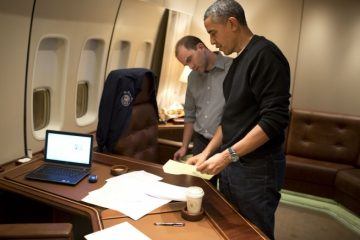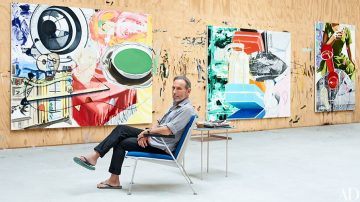by Robert Fay
I’m not typically a reader of White House memoirs, but after finishing the new biography of diplomat Richard Holbrooke, Our Man (2019) by George Packer, I became intrigued by depictions of Obama’s management style in dealing with Holbrooke, Hilary Clinton and others. I soon picked up The World As It Is (2018) by former Obama advisor Ben Rhodes, which has been described as the best “inside” look of Obama to date. Rhodes tells us enough Obama anecdotes to bring the man into focus. And while none of it is terribly surprising, I was intrigued to learn that Obama, despite being President, continued to see himself as an outsider, as someone who, by virtue of his own personal journey and outlook, could never truly become enculturated to power and authority, despite being the executor of state power for eight years.

It seemed Obama’s self-view as an outsider had less to do with being African-American or as someone who had lived in Indonesia as a child, but more to do with being, at heart, a writer (it’s no coincidence that Rhodes, one of his closest advisors, was a speechwriter who had an MFA in creative writing from NYU). Obama’s memoir Dreams from My Father (1995) garnered the kind of literary praise that few politicians since Winston Churchill have received. During his presidency, Obama carved out four or five hours of “alone-time” in the White House Treaty room each night to read books, review documents and often just to think. Obama’s famous coolness, his so-called detachment, was likely a misreading of his observational mode with people, a common trait among writers who find you can learn more from a “scene” by observing people than by inserting yourself into the action.
But most of all, I was struck by a random comment Obama made to Rhodes regarding criticism from American Jews over his Israel policy. “I came out of the Jewish community in Chicago,” he said. “I’m basically a liberal Jew.”
On one level, Obama was referencing a political outlook, but a man of his sophistication and sensitivities was also naming a kinship with a certain cultural and societal point-of-view born of the American Jewish diaspora. Here was Obama, a member of the most marginalized group in the U.S., African Americans, donning an additional garment of outsiderness, that of being Jewish.
And I understood this sentiment in a deeply personal way. In 1985 my family moved to Peabody, Massachusetts, settling in the predominately Jewish section of the city, West Peabody. I was a 14-year-old Irish-Catholic kid from Boston’s South Shore (what used to be called the “Irish Riviera”) and I don’t think I’d ever met a Jewish person until then, but within a short time, nearly all my friends were Jewish. I grew up a block from the comedian Gary Gulman. In a 2018 podcast with Judy Gold, Gulman said of our West Peabody neighborhood, “If you lived there, you’d be like, ‘oh, Jew.’ All the Jews lived in West Peabody…because it was in walking distance of the synagogue.”
In West Peabody I was an outsider, growing up among the outsiders (but made to feel like an insider), which ultimately made me feel a bit separate from what—for lack of a better cliché—might be termed “white bread” America.

It’s curious that an African-American president articulated something I’d always felt, but never imagined I could proclaim: that growing up among Jews had given me a different perspective on America, one that was more cosmopolitan, more knowingly skeptical, and yet also steeped in a kind of (semi-hopeful) liberalism that has become the default religion of many secular Jews.
In the podcast Gulman and Gold have fun bantering about Jewish identity. “Do you feel like, Jewy,” Gold asks. “Yeah, I’m very Jewy…it permeates my very being,” Gulman says. I smile as I listen, feeling a kind of kinship that I would never feel listening to people joke about being Catholic or Irish-American. Spending my formative years with Jewish friends, laughing at Jewish jokes and hanging out in Jewish homes has left an indelible marker on who I am. And though I understand cultural affinity only goes so far—the neo-NAZI, white nationalists marching in Charlottesville, Virginia, weren’t explicitly an existential threat to me—I will always feel connected, perhaps in the way that Obama was trying to articulate.
*
Like many writers, I marvel at the work of journalist Janet Malcolm, and in particular her famous 1994 piece, “Forty One False Starts,” about her anxiety of how to begin her profile of the painter David Salle. It’s a brilliant pioneering work of narrative nonfiction, but among the countless jewels in the piece, there is an interesting quote by Salle about who can be a legitimate outsider: “…in art politics, to be homosexual is, a priori, more correct than to be heterosexual. Because to be an artist is to be an outsider, and to be a gay outsider is to be a double outsider. That’s a correct condition. If you’re a straight artist, it’s not clear that your outsiderness is legitimate.” Salle then articulates something that Spike Lee has often stated, that much of what is culturally interesting in America has been done by African Americans (though Salle adds the contributions of gay people as well).
What’s interesting here is the certainty that art is created by outsiders, and that the “most correct” art is created by homosexuals, because of their true, undeniable exclusion (more so in 1994 than 2019) from mainstream, conventional American culture.
A quick survey of the artists I love seems to reinforce this outsider theory of art making: Marcel Proust was Jewish and gay in 19th Century Catholic France; Jack Kerouac, a child of French-Canadian immigrants, spoke Joual (Quebec French) as a first language; Andy Warhol, was the gay son of Slovakian immigrants; Flannery O’Connor was a Catholic woman in the Protestant South; Samuel Beckett, was the prosperous Protestant boy in economically poor, Catholic Ireland; and Susan Sontag, if we use Salle’s model, was a “triple outsider:” Jewish, lesbian and feminist. I could go on, but it would seem obvious that social marginalization in one form or another can create a certain “distance” from mainstream society, which artists can make us of.

But social marginalization alone won’t help the hack or the dilettante; only talent, intellect and originality can make use of the pains of social prejudice and exclusion. But we should also point out that many great white, male, heterosexual artists were born in comfortable middle-to-upper class settings and this in no way stifled their talent. Some of the names that come easily to mind are Tolstoy, Robert Lowell, Ernest Hemingway or, for a more recent example, the outstanding British novelist Edward St. Aubyn, whose family is rather “illustrious” and aristocratic.
In 2018 The New Yorker staff writer Katy Waldman published “Best Books of the 2018.” It’s a list that I can’t help feeling was born of a somewhat self-conscious exercise. These are undoubtedly important writers, whose books appear on a number of other “best of” lists, but it is worth noting that every writer on the list is an outsider vis-à-vis the Anglo-American literary world (question: does this place even exist anymore?), if we define insiderness as someone who resembles Jonathan Franzen or Edward St. Aubyn, in other words male, white and heterosexual (a definition I personally don’t put stock in, for I think insiderness derives far more from class and institutional connections, e.g., MFA programs and Arts Organizations).
The most likely and reasonable interpretation of Waldman’s list is that these are simply the books Waldman read and loved, but I can’t help thinking there is also a political component at work: that these are the books that “are most correct” to read if you are a liberal anglophone who lives in New York City, Toronto or London and keeps up with The New Yorker.
And speaking of Franzen, Adam Kirsch in his fine book on the literary critic Lionel Trilling, Why Trilling Matters (2011), notes how Franzen, despite millions of readers, worried about his marginalization among the public. “Frazen, realizing how insignificant the biggest best seller is compared to the audience for a movie of a videogame, is haunted even in success by ‘the larger circumstance of defeat.’”
The critics of Franzen are legion, and one can hear them ridiculing his sense of entitlement, but Franzen is a legit writer and artist and The Corrections (2000) is a superb novel that will outlast all the present-day sniping.
It’s not impossible to understand how Obama or Franzen, despite their power and influence, can feel like outsiders: Obama has been on the receiving end of racism and a nasty ideological antagonism, while Franzen is the ongoing subject of vicious envy from lesser writers. Read the essay “Hating Jonathan Franzen,” and you can see why Franzen is reluctant to get a on Twitter and begin chatting with the online literati.
When I think of the great mid-20th century Jewish American writers, men like Saul Bellow, Philip Roth, J.D. Salinger, Bernard Malamud, Allen Ginsberg—and I’ll throw in the composer Aaron Copland for good measure—their differentness from what was then defined as WASP America, turned out to be an indelible gift to our culture. And the same thing is happening today with American writers mining their backgrounds from South Asia, Africa and Central America. They are the new outsiders, who will one day become insiders, and be doing so, tweak the every-changing notion of what it means to be a true, blue American.
Robert Fay’s essays, reviews and stories have appeared in The Atlantic, The Millions, The Los Angeles Review of Books and The Chicago Quarterly Review, among others. He is co-creator of the Feeling Bookish Podcast. Follow him on Twitter @RobertFay1.
